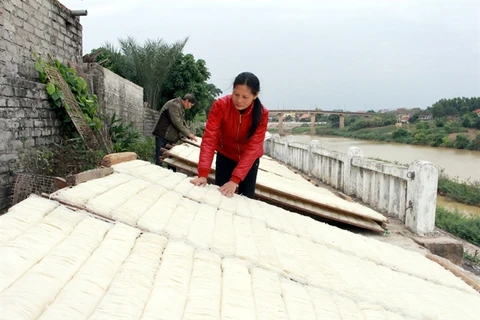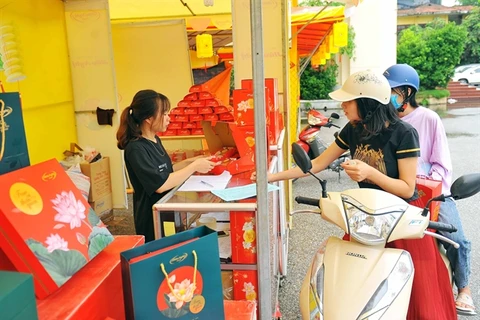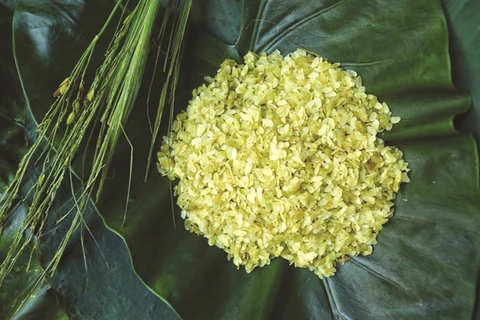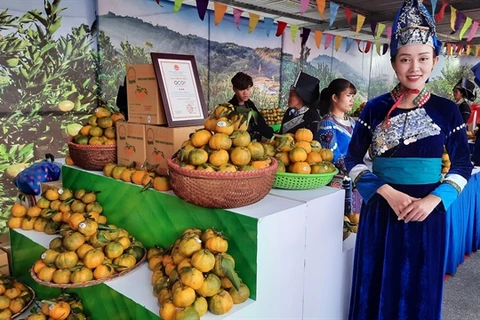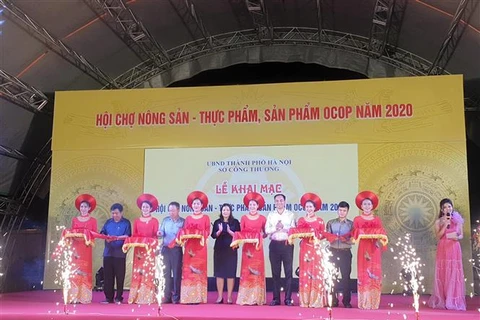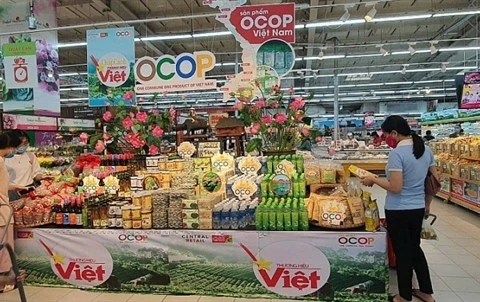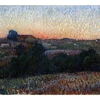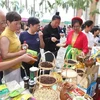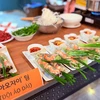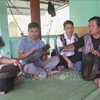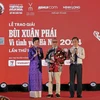Hanoi (VNA) - Dishes not only demonstrate the skillfulness and resourcefulness of a homemaker and special features of each locality, but also reflect the cultural identity of each nation. A country with tropical agriculture, Vietnam is home to thousands of unique farm produce that serve as ingredients for a myriad of dishes.
The Eastern land, as Hai Duong was formerly called, has long been famous for its specialities. Once coming here, visitors will never fail to buy Ke Sat dry pancake, Thanh Ha lychee, and especially “banh dau xanh” (mung bean cake) and “banh gai” (glutinous rice cake dyed black with a concoction of pinnate leave) of Ninh Giang township as present for their relatives back home. Those presents themselves can tell tourists about the land they have just visited and the skillfulness of local people since the specialities illustrate this land’s unique cultural identity that can be found nowhere else in Vietnam.
“Banh dau xanh” (mung bean cake)
The “banh dau xanh” speciality of Hai Duong is made from very simple ingredients: mung bean, sugar, pork fat, and grapefruit flower essence. Elderly artisans of the traditional cake making village in Hai Duong city take pride of the uniqueness as it is created via extremely meticulous steps that require makers’ skillfulness and delicacy.
Mung bean must be carefully selected to be green-peeled and yellow-fleshed which will later be roasted, milled, peeled and then roasted again on small fire again until beans are cooked and turn yellow. After that, beans will be ground and sieved into fine powder.
Meanwhile, fresh pork fat is fried on small fire until it becomes transparent and releases fragrance. If the fat is over-fired, the cakes will have a smell of burning, but they won’t have fragrance or rich taste if the fat is under-fired. Refined sugar is dissolved in water and filtered by using egg whites. Grapefruit flowers, added with coriander and roosts of “tong bai” (a local plant species), are distilled for essence.
The four ingredients are mixed appropriately, compressed and cut into small blocks before the pieces are packaged.
Prior to 1945, there were a number of facilities making and selling “banh dau xanh”in the then Hai Duong town such as Hoa Mai and Mai Phuong, but the most renowned were Bao Hien and Cu Huong. The local elderly said Bao Hien, owned by Nguyen Thi Nhung, was the first to produce “banh dau xanh” in Hai Duong city. Each time it purchased inputs, the entire town became busier than normal days as there were carriages loaded with sugar from central Tuy Hoa city to Hai Duong in the north, big boats with mung bean from Luc Nam, and hundreds of kilogrammes of fat delivered to the maker’s warehouse from slaughterhouses. At that time, labourers of Bao Hien worked around the clock, and all steps from material check, transaction and management to accounting were singlehandedly handled by a woman who also had to look after her small children, but everything still went smoothly. That skillful and dynamic woman turned “banh dau xanh” into a renowned speciality of Hai Duong. Also thanks to her, Bao Hieu became the largest brand of “banh dau xanh” in the Eastern land in the 1960s and 1970s.
Aside from Bao Hien, Cu Huong was also a famous producer then. Despite modest output, its products were known for their quality.
In 1986, Doan Van Dat established the brand of Nguyen Huong, which uses a phoenix image for its logo. The name of Nguyen Huong (original fragrance) and the phoenix logo were intended to show his wish to preserve the original taste of Hai Duong’s mung bean cake so that this unique delicacy would be known far and wide across the country. Nguyen Huong won a silver medal for its quality at the national handicraft fair in 1987 and a gold medal at the 1998 edition, which created a driving force for the development of “banh dau xanh” in terms of both quantity and quality.
A “banh dau xanh” packaging workshop.
Apart from quality, producers in Hai Duong city have also made the product distinctive by creating a particular appearance for it. Although there are hundreds of mung bean cake brands, most of them are wrapped in yellow and red packages as these are “traditional colours” dating back from the time Bao Hien founded the craft.
Not only preserving the craft, producers nowadays have also made innovations. To keep the quality unchanged for from two to six months, the cakes are wrapped in aluminum foil instead of plastic film and put in anti-moisture packages. Sugar-free products are also available for consumers on a diet. Meanwhile, housewives can also make mung bean cake on their own by following producers’ instructions. Depending on their preference, buyers can also choose products with suitable sweetness. Besides, some producers also add red bean, lotus seed, peanut or even egg yolks to their cake, thus diversifying the products. Hai Duong city is now home to hundreds of mung bean cake producers. The product has not only won domestic consumers’ trust but also been exported to markets around the world.
“Banh gai” (black glutinous rice cakes) of Ninh Giang township, Ninh Giang district
Many elderly residents in Ninh Giang township said the making of banh gai here dated back more than 700 years ago and originated from a village of Gia Loc district. At first, they had a round shape and weren’t wrapped in leaves. To have more delicious cakes, first makers found out a perfect recipe and standardised production techniques. “Nep cai hoa vang” (a glutinous rice speciality), dry “gai” (ramie) leave, mung bean, lotus seed, coconut and sesame are mixed in a secret recipe and then wrapped in dry banana leave before being steamed.
With simple brown covers, “banh gai” is a valuable speciality because a delicious cake meeting standards requires meticulous touches in each step of making. For example, to make the dough, producers have to use ramie leave hailing from Nam Dinh province. The leaves are washed, well-stewed, then washed again and mixed with sugar for two or three days. After that, producers crush the leave to take fine powder which will later be mixed with glutinous rice powder. The ratio of leave and glutinous rice powder will decide the quality of the cakes’ outer layer.
Holding “banh gai” against the sunlight, gourmets will realise that the cakes turn from black to dark green and they can see tiny fine ramie leave grains. These are also the criteria telling the difference among producers.
Meanwhile, preparing fillings is also a meticulous step. Pigs’ neck fat is kept in sugar in a particular way to remove its greasiness and make it crispy. Lotus seeds also need to be prepared in a way that ensures softness but still preserves their taste.
In the first decades of the 20th century, “banh gai” was a popular item sold in the Chanh wharf, which is also why the product used to be called “banh do Chanh” (Chanh wharf’s cake).
In Ninh Giang township, there were two major production facilities of “banh gai” in the 1940s, Ngoc Chau and Ngoc Anh. There were also two famous stores near the Chanh wharf, namely Bep Bai and Huong Tu. Returning to Ninh Giang township today, visitors will see many new brands like Minh Tan, Nhan Hung and Tuyet Trung. Ninh Giang “banh gai” is like a simple rural present that has been available in various places such as Thai Binh, Hai Phong, Hung Yen and Hanoi. In particular, buying “banh gai” in Ninh Giang township, consumers will never have to worry about whether or not the cakes are made from any type of leaves other than ramie, since whoever producing such products will be boycotted by other local producers and people.
Thuy Lam lychee (Thanh Son commune, Thanh Ha district)
Centuries ago, Thanh Ha was renowned for areca, orange and brackish water products. Later, lychee became another speciality of this land thanks to their deep sweetness and fragrance.
Thuy Lam lychee was first cultivated by Hoang Van Com (1848 – 1923) almost a century ago. The local elderly said he was not rich but often travelled and made friends with many people. Once attending a party of a Chinese in Hai Phong, he tasted a very delicious fruit and decided to bring seeds home to plant. All the three seeds sprouted, and one of them grew up and bore delicious fruits. After that, Com popularised it by presenting cuttings to his friends. As a result, lychee was seen across Thanh Son commune and then Thanh Ha and Chi Linh districts, and spread to Hung Yen, Bac Giang and Thanh Hoa. Particularly, the fruit developed strongly in Chu township of Luc Ngan district, Bac Giang province. It is now the main source of income for residents in Thanh Ha.
To express their gratitude, locals built a shrine dedicated to Com near the original tree and honoured him as the lychee ancestor. People in large lychee farming areas nationwide nowadays are also grateful to the first grower as seen in their words written on the baldachin and in remembrance books at the shrine.
From the first tree, lychee has developed and now covers the entire Thanh Ha. Every year, tens of thousands of people from across Vietnam visit the original tree to learn about the coming into being of the famous delicacy. The site has also attracted a large number of visitors from other countries such as France, the US and Laos.
The original lychee tree.
Today, Thanh Ha is blanketed with the greenery of lychee farms all year round, even in autumn or winter. In spring, light yellow blossoms are in full bloom, promising a bumper lychee crop. At the arrival of summer, tens of thousands of trees across the district become laden with blazing red lychees. Here, summer is considered the season for enjoying the quintessence of the fertile land.
Apart from “banh dau xanh”, “banh gai” and lychees, visitors to Hai Duong can also taste Gia Loc pork pie, Kim Thanh glutinous rice, Chi Linh custard apple and banana, and Ke Sat – Binh Giang dry pancake. The precious but simple specialities of Hai Duong reflect not only the identities of this land but also the warm-heartedness, skillfulness and unique culinary culture of local people./.

